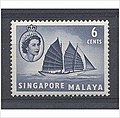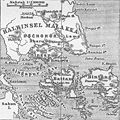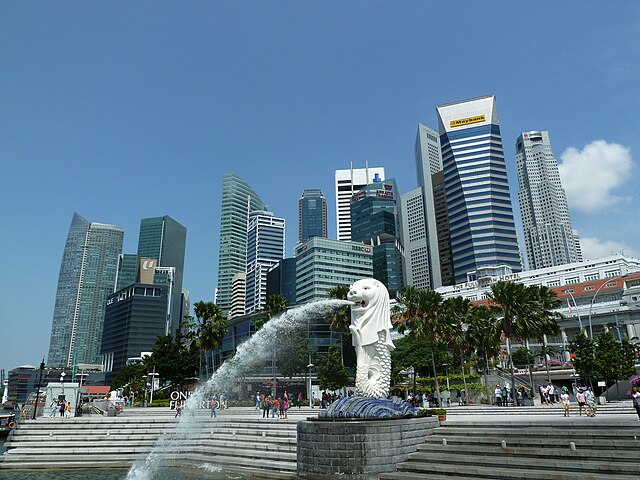Portal:Singapore
Wikipedia portal for content related to Singapore / From Wikipedia, the free encyclopedia
Portal maintenance status: (May 2020)
|
 Map of Singapore Singapore, officially the Republic of Singapore, is an island country and city-state in maritime Southeast Asia. It is located about one degree of latitude (137 kilometres or 85 miles) north of the equator, off the southern tip of the Malay Peninsula, bordering the Strait of Malacca to the west, the Singapore Strait to the south along with the Riau Islands in Indonesia, the South China Sea to the east, and the Straits of Johor along with the State of Johor in Malaysia to the north. The country's territory comprises one main island, 63 satellite islands and islets, and one outlying islet; the combined area of these has increased by approximately 25% since the country's independence as a result of extensive land reclamation projects. It has the second highest population density of any country in the world, although there are numerous green and recreational spaces as a result of urban planning. With a multicultural population and in recognition of the cultural identities of the major ethnic groups within the nation, Singapore has four official languages: English, Malay, Mandarin, and Tamil. English is the lingua franca, with its exclusive use in numerous public services. Multi-racialism is enshrined in the constitution and continues to shape national policies in education, housing, and politics.
Singapore's history dates back at least eight hundred years, having been a maritime emporium known as Temasek and subsequently a major constituent part of several successive thalassocratic empires. Its contemporary era began in 1819, when Stamford Raffles established Singapore as an entrepôt trading post of the British Empire. In 1867, the colonies in Southeast Asia were reorganised, and Singapore came under the direct control of Britain as part of the Straits Settlements. During World War II, Singapore was occupied by Japan in 1942 and returned to British control as a separate Crown colony following Japan's surrender in 1945. Singapore gained self-governance in 1959 and, in 1963, became part of the new federation of Malaysia, alongside Malaya, North Borneo, and Sarawak. Ideological differences, most notably the perceived encroachment of the egalitarian "Malaysian Malaysia" political ideology led by Lee Kuan Yew into the other constituent entities of Malaysia—at the perceived expense of the bumiputera and the policies of Ketuanan Melayu—eventually led to Singapore's expulsion from the federation two years later; Singapore became an independent sovereign country in 1965. After early years of turbulence and despite lacking natural resources and a hinterland, the nation rapidly developed to become one of the Four Asian Tigers. With its growth based on international trade and economic globalisation, it integrated itself with the world economy through free trade with minimal-to-no trade barriers or tariffs, export-oriented industrialisation, and the large accumulation of received foreign direct investments, foreign exchange reserves, and assets held by sovereign wealth funds. As a highly developed country, it has one of the highest GDP per capita (PPP) in the world. Identified as a tax haven, Singapore is the only country in Asia with a AAA sovereign credit rating from all major rating agencies. It is a major aviation, financial, and maritime shipping hub and has consistently been ranked as one of the most expensive cities to live in for expatriates and foreign workers. Singapore ranks highly in key social indicators: education, healthcare, quality of life, personal safety, infrastructure, and housing, with a home-ownership rate of 88 percent. Singaporeans enjoy one of the longest life expectancies, fastest Internet connection speeds, lowest infant mortality rates, and lowest levels of corruption in the world. Singapore is a unitary parliamentary republic with a Westminster system of unicameral parliamentary government, and its legal system is based on common law. It retains both corporal punishment for minor offences and capital punishment for serious ones. While the country is de jure a multi-party democracy, the government under the People's Action Party (PAP) wields widespread control over politics and society without serious electoral competition. In 2023, Singapore was ranked 129th out of 180 nations on the global Press Freedom Index due to government restrictions on freedom of speech and freedom of the press. For these reasons, Singapore has been described by scholars as a soft authoritarian state or an illiberal democracy. The PAP has governed the country continuously since full internal self-government was achieved in 1959, and currently holds a supermajority with 79 out of 93 elected seats in Parliament. One of the five founding members of ASEAN, Singapore is also the headquarters of the Asia-Pacific Economic Cooperation Secretariat, the Pacific Economic Cooperation Council Secretariat, and is the host city of many international conferences and events. Singapore is also a member of the United Nations, the World Trade Organization, the East Asia Summit, the Non-Aligned Movement, and the Commonwealth of Nations. (Full article...)Selected article - show anotherNicoll Highway MRT station is an underground Mass Rapid Transit (MRT) station on the Circle Line (CCL) in Singapore. Located in the Downtown Core underneath Republic Avenue near the Kallang River, the station serves commercial and residential developments along Nicoll Highway, such as the Golden Mile Complex and The Concourse. The station is operated by SMRT Trains. First announced as part of the Marina MRT line (MRL) in 1999, the station was incorporated into Stage 1 of the CCL in 2001. During the construction, the tunnels linking to the original station site caved in along with the highway on 20 April 2004, killing four people. Following an investigation, which found human error and organisational failures as causes of the collapse, the station was relocated. Alongside the other stations on Stages 1 and 2 of the CCL, the station opened on 17 April 2010. (Full article...)Selected picture
Resorts World Sentosa, one of the two Integrated Resorts in Singapore. This view is from the Tiger Sky Tower. Read more...
General imagesThe following are images from various Singapore-related articles on Wikipedia.
Selected biography - show anotherXiaxue at the National Library in September 2005 Did you know (auto-generated)
In this month
More did you know - show different entries
Selected panorama
VivoCity (Chinese: 怡丰城) is the largest shopping mall in Singapore, located at the HarbourFront precinct . Opened on 7 October 2006, it marked the completion of the main structure by a topping-out ceremony on 18 April 2006 and was officially opened on December 1, 2006.
Singapore topicsRelated portalsSoutheast Asia Other Countries Tasks
CategoriesWikiprojectsAssociated WikimediaThe following Wikimedia Foundation sister projects provide more on this subject:
Discover Wikipedia using portals |






























































